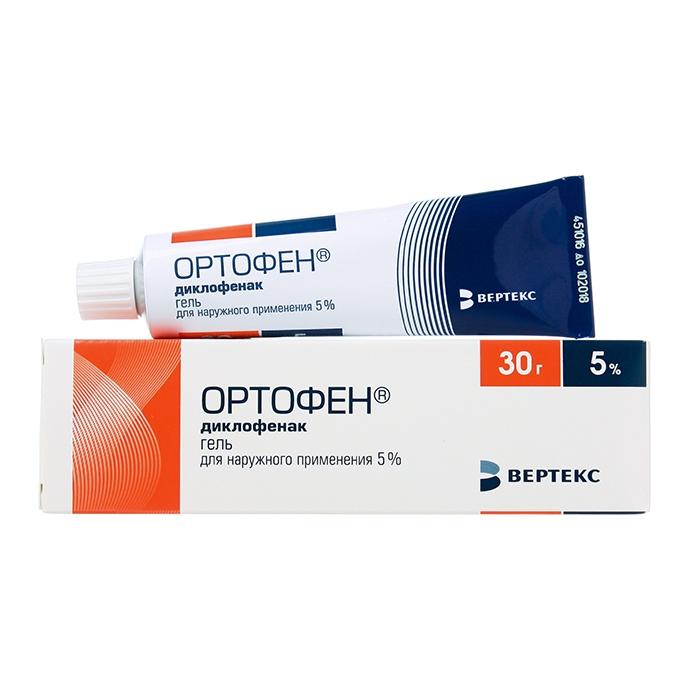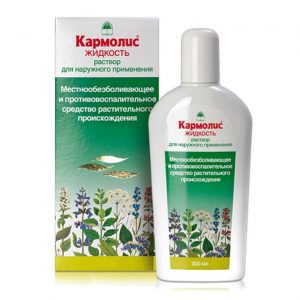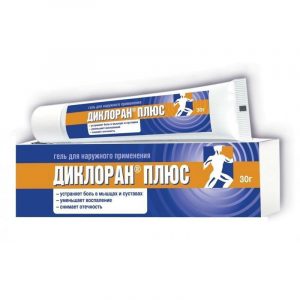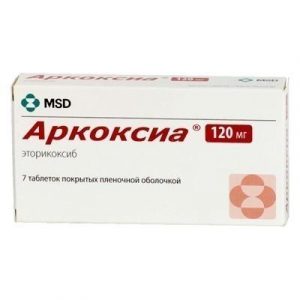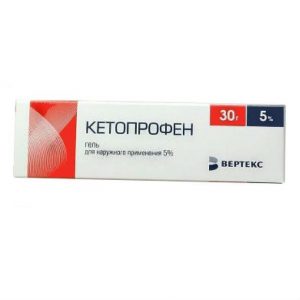Description
Release form
Gel for external use.
Packing
Tube, 30g.
Pharmacological action
NSAIDs, a derivative of phenylacetic acid. It has a pronounced anti-inflammatory, analgesic and moderate antipyretic effect. The mechanism of action is associated with the inhibition of COX activity – the main enzyme of the metabolism of arachidonic acid, which is a precursor of prostaglandins, which play a major role in the pathogenesis of inflammation, pain and fever. The analgesic effect is due to two mechanisms: peripheral (indirectly, through the suppression of prostaglandin synthesis) and central (due to inhibition of prostaglandin synthesis in the central and peripheral nervous system).
Inhibits proteoglycan synthesis in cartilage.
In rheumatic diseases, it reduces joint pain at rest and during movement, as well as morning stiffness and swelling of the joints, contributes to an increase in range of motion. Reduces post-traumatic and postoperative pain, as well as inflammatory edema.
Suppresses platelet aggregation. With prolonged use it has a desensitizing effect.
When applied topically in ophthalmology, it reduces swelling and pain in inflammatory processes of a non-infectious etiology.
Indications
Joint syndrome (rheumatoid arthritis, osteoarthritis, ankylosing spondylitis, gout), degenerative and chronic inflammatory diseases of the musculoskeletal system (osteochondrosis, osteoarthrosis, periarthropathy), post-traumatic inflammation of the soft tissues and musculoskeletal system (sprains, bruises). Pain in the spine, neuralgia, myalgia, arthralgia, pain and inflammation after operations and injuries, pain in gout, migraine, algodismenorrhea, pain in adnexitis, proctitis, colic (biliary and renal), pain in infectious and inflammatory diseases of ENT organs.
For local use: inhibition of myosis during cataract surgery, prevention of cystoid macular edema associated with removal and implantation of the lens, inflammatory processes of the eye of a non-infectious nature, post-traumatic inflammatory process with penetrating and non-penetrating wounds of the eyeball.
Contraindications
Erosive and ulcerative lesions of the gastrointestinal tract in the acute phase, aspirin triad, hematopoiesis of unknown etiology, hypersensitivity to diclofenac and the components of the applied dosage form, or other NSAIDs.
Special instructions
Use with extreme caution in case of liver, kidney, gastrointestinal diseases in the anamnesis, dyspeptic symptoms, bronchial asthma, arterial hypertension, heart failure, immediately after serious surgical interventions, as well as in elderly patients.
For indications of a history of allergic reactions to NSAIDs and diclofenac sulfites, they are used only in urgent cases. In the process of treatment, systematic monitoring of liver and kidney function, peripheral blood picture is necessary.
Rectal administration in patients with a history of anorectal disease or a history of anorectal bleeding is not recommended. Topically, it should be used only on intact skin areas.
Avoid contact with diclofenac in the eyes (with the exception of eye drops) or on the mucous membranes. Patients using contact lenses should apply eye drops no earlier than 5 minutes after removing the lenses.
Not recommended for use in children under 6 years of age.
Alcohol is not recommended during the period of treatment with dosage forms for systemic use.
Effect on the ability to drive vehicles and control mechanisms
During the treatment period, a decrease in the speed of psychomotor reactions is possible. If visual clarity deteriorates after applying eye drops, you should not drive or engage in other potentially hazardous activities.
Composition of
100 g of gel contains:
Active ingredient:
diclofenac sodium – 5.0 g.
Excipients:
propylene glycol – 5.0 g,
ethanol 95% (ethyl alcohol 95%) – 30.0 ,
hyetellose (hydroxyethyl cellulose) – 2.5 g,
purified water – up to 100.0 g
Dosage and administration
For oral administration for adults, a single dose is 25-50 mg 2-3 times / day. The frequency of administration depends on the dosage form used, the severity of the disease and is 1-3 times / day, rectally – 1 time / day. For the treatment of acute conditions or relief of exacerbation of the chronic process, IM is used in a dose of 75 mg.
For children over 6 years of age and adolescents, the daily dose is 2 mg / kg.
Topically applied in a dose of 2-4 g (depending on the area of the painful area) to the affected area 3-4 times / day.
When used in ophthalmology, the frequency and duration of administration are determined individually.
The maximum daily dose for adults when taken orally is 150 mg / day.
Side effects of the
From the digestive system: nausea, vomiting, anorexia, pain and discomfort in the epigastric region, flatulence, constipation, diarrhea in some cases – erosive and ulcerative lesions, bleeding and perforation of the gastrointestinal tract rarely – impaired liver function. With rectal administration in rare cases, inflammation of the colon with bleeding, exacerbation of ulcerative colitis was noted.
From the side of the central nervous system and peripheral nervous system: dizziness, headache, agitation, insomnia, irritability, rare tiredness – paresthesia, visual impairment (vagueness, diplopia), tinnitus, sleep disturbances, convulsions, irritability, tremors, mental disorders, depression.
From the hemopoietic system: rarely – anemia, leukopenia, thrombocytopenia, agranulocytosis.
From the urinary system: rarely – impaired renal function in susceptible patients, edema is possible.
Dermatological reactions: rarely – hair loss.
Allergic reactions: skin rash, itching when applied in the form of eye drops – itching, redness, photosensitivity.
Local reactions: burning may occur at the site of the i / m injection, in some cases – the formation of infiltrate, abscess, adipose tissue necrosis with rectal administration, local irritation, the appearance of mucous secretions with an admixture of blood, painful defecation with external use in rare cases – itching, redness, rash, burning with local application in ophthalmology, a transient burning sensation and / or temporary blurred vision immediately after instillation are possible.
With prolonged external use and / or application to extensive body surfaces, systemic side effects are possible due to the resorptive effect of diclofenac.
Drug Interactions
With the simultaneous use of antihypertensive drugs with diclofenac, their effect may be weakened.
There are few reports of seizures in patients who took NSAIDs and antibiotics of the quinolone series at the same time.
With simultaneous use with corticosteroids, the risk of side effects from the digestive system increases.
With the simultaneous use of diuretics, a decrease in the diuretic effect is possible. With simultaneous use with potassium-sparing diuretics, an increase in the concentration of potassium in the blood is possible.
When used concomitantly with other NSAIDs, an increased risk of side effects is possible.
There are reports of the development of hypoglycemia or hyperglycemia in patients with diabetes who used diclofenac along with hypoglycemic drugs.
With simultaneous use with acetylsalicylic acid, a decrease in the concentration of diclofenac in blood plasma is possible.
Although clinical studies have not established the effect of diclofenac on the action of anticoagulants, some cases of bleeding have been described with the simultaneous use of diclofenac and warfarin.
With simultaneous use, an increase in the concentration of digoxin, lithium and phenytoin in the blood plasma is possible.
Absorption of diclofenac from the gastrointestinal tract decreases with simultaneous use with colestyramine, to a lesser extent – with colestipol.
With simultaneous use, it is possible to increase the concentration of methotrexate in blood plasma and increase its toxicity.
With the simultaneous use of diclofenac, it may not affect the bioavailability of morphine, however, the concentration of the active metabolite of morphine may remain elevated in the presence of diclofenac, which increases the risk of side effects of the morphine metabolite, including respiratory depression.
With simultaneous use with pentazocine, a case of the development of a large convulsive seizure with rifampicin is described – a decrease in the concentration of diclofenac in plasma with ceftriaxone is possible – excretion of ceftriaxone with bile with cyclosporine is increased – cyclosporin nephrotoxicity may increase.
overdose
Symptoms: Due to low systemic absorption, overdosage is unlikely when gel is applied. In case of accidental ingestion, systemic adverse reactions may develop.
Treatment: Gastric lavage, vomiting induction, activated charcoal, forced diuresis, symptomatic therapy. Dialysis is not effective due to the high degree of binding of diclofenac to proteins (about 99%).
Storage conditions
Keep out of the reach and sight of children at temperatures not exceeding 25 ° C.
Shelf life
2 years.
Deystvuyushtee substance
Diclofenac
Conditions of drugstore
No prescription
Possible product names
Ortofen gel 5% 30 g
Vertex, Russia
